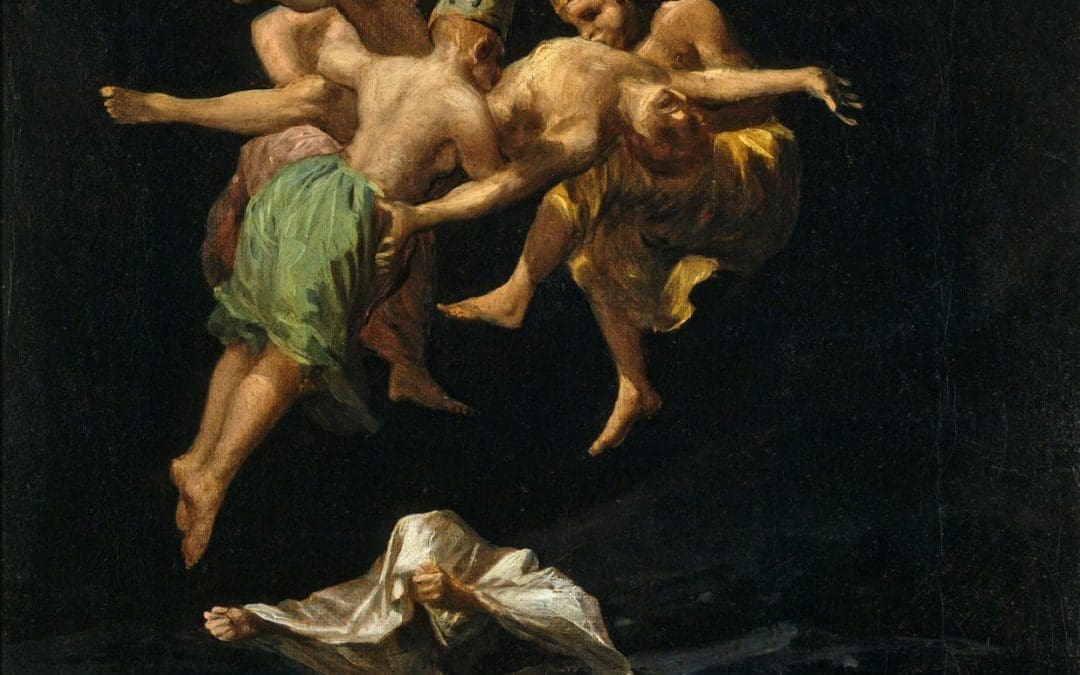Goya. (1798) Witches’ Flight
Recently my thoughts and research ( see previous post) have turned to the rugs (flying, seems to be a theme right now!) which I have been making for my boys and the work with my own hair that I have been processing for now into one long line, tying each strand to the next to form a long thread which will be turned into ….hmmm something towards our final show next year! I feel very settled and peaceful in my practice after this lockdown, last year there was a slight whiff of mild panic!
When I started making the rugs for the boys they would come home from school and pop into see how much of it I had done that day “Is that all mummy”, “wait, what?” “It takes ages love, probably around a month plus for each”, “Oh OK”! However, all they really wanted to do was touch it and feel the softness of the material and see the colours, “Oh I remember wearing this when we went to ….”and off the story would go, they started to engage with it more and more through their imprinting of their own memories, trips, atmospheres, telling offs, smells, and tastes! The biggest “Oh Wow” moment came about when my youngest asked if I was making a magical carpet for him to fly away on, “can I go when were I want on it”, “yep of course you can ”, “anywhere, like space”? “of course, you can go anywhere you want, that’s the idea of the magic flying carpet”, “but it’s a rug mummy”, “hahaha yeah Ok, a rug: Rug from the old norse word Rogg (shaggy or tuft) … basically by the 1900’s it was a rug which had come to mean floor mat. A carpet from the Old Italian word Carpita, (a thick cloth made of wool) which is also defined as “to pluck”. Some carpets were used on beds; some on the wall, but by the 1400/1500’s most were laid down on the floor, some were wall to wall!
 Leitch, F. (2021) Rugback.
Leitch, F. (2021) Rugback.
I came across an article on The Guardian website which I touched upon in my previous blog, entitled “Magic carpets: the art of Faig Ahmed’s melted and pixulated rugs.” By Paula Cocozza 2016 regarding the Azerbaijani artist Faig Ahmed. His rug work started at the the age of seven of cutting up a family rug (an heirloom) in his bedroom with a large pair of scissors, to see how he could redefine its shape, colour play and pattern. Most of the rugs in his Baku home were removed after! Ahmed’s work takes traditional patterns with meanings dating back thousands of years with huge cultural meaning, and redefines them by chopping up or melting colours together. The cultural background, political history and modern techniques in design are all brought together in a clashing disorientating way. The pixelated and digital aesthetic breaks down the traditional values of not just the skill of making carpets, but through the removal of borders and structure as discussed by Cocozza (2016). Ahmed’s work tells of the political unrest of his home country after the break-up of the USSR. Ahmed states “it was not an easy time…it threw settled structures into unrest”. However it is Ahmed’s last quote that hit me “…each knot is a kind of pixel, and that long ago carpets were as important as our smartphones, used by shamans to jump to subconscious or parallel worlds”. The traveling, the transcendence of body and mind to achieve either enlightenment or a greater understanding of our personal, social, political, sexual power, cultural situation/background…or simply to find and understanding control surrounding the happenings of today.
 Faig Ahmed (2010) Traditional Pixel
Faig Ahmed (2010) Traditional Pixel
However, you have to actually want to sit on a ceremonial rug/carpet, contemplate the pattern and symbols beneath your sit bones, feel the textile’s nap, smell the object, its dust of people past, its impregnation of energy of past flights and dreams; wants, needs, or understandings. Allow that connection of your flesh against its waft or weft to hold your physical being while you begin the journey into a state of mental otherness, thus jumping into your subconscious or a parallel world to find what you need. Much like the free diving a few posts ago, I actually want to see if I can find that “other world” feeling by holding my breath underwater, admittedly it’s not for everyone. I do meditate, only for the past year though, however I still have to have the right environment and space, physically and mentally to achieve that “astral plane” and awareness and disconnection I feel I need at times. Does the rug I sit on matter? Does the object hold that power to transcend the mundane, past melancholy, sentiment or nostalgia? Of course, ritualistically history is riddled with objects that can heal, channel, etc…beauty is in the eye of the beholder…(voodoo doll)… you can believe or create whatever you want, if you are allowed the freedom to do so!
*
Transmutating of the domestic object.
“The Broom was a symbol of female domesticity, yet the broom was also phallic, so riding on one was a symbol of female sexuality, thus femininity and domesticity gone wild” Dylan Thuras Atlas Obscura (2014).
 Plastic Broom (2021)
Plastic Broom (2021)
One of the most basic humble domestic objects to ever be transcended to the “other” has to be the broom. Common pagan fertility rituals were poles (Maypoles especially, which I took part in as a child…as you can guess from my posts I grew up in a rural area in the UK with strong pagan and wiccan beliefs, yet I went to a church of England primary school…ever seen the original film the Wicca man with Edward Woodward?) pitchforks etc were dug into fields and women were to jump over them, brooms at weddings were jumped over too. Thuras (2014) discusses this in his article Sex Drugs and broomsticks: The origins of the iconic witch and refers to Reginald Scot’s book The discovery of Witchcraft, (1584) “At these magical assemblies, the witches never failed to dance; and in their dance they sing these words,’Har, har, divell, divell, dance here dance, plaie here plaie here, Sabbath, Sabbath.’ And whiles they sing and dance, ever one hath a broom in her hand, and holdeth it up aloft”. Such folk traditions are so very common all around the world, however it’s the dark side of the tradition which holds such disturbance, the object seen as a tool for wrong doing in the eyes of the church, became one of the symbols for Satan’s actions. This object then combined with the ownership of a mix of hallucinogenic drugs, such as Ergot (which is very similar to LSD), mandrake and deadly nightshade, were mixed with animal fat and allegedly used in flying ointment. The outcome is obvious.
Each part of my body seemed to be going off on its own, and I was seized with the fear that I was falling apart. At the same time I experienced an intoxicating sensation of flying…I soared where my hallucinations – the clouds, the lowering sky, hoards of beasts, falling leaves…billowing streams of steam and rivers of molten meta l- were swirling along. A description of the experience after taking flying ointment by the German writer Gustav Schenk in 1966.
These drugs were quite deadly if swallowed so were applied to parts of the body through the mucus membranes, under the arms, through the anus, or for women through the mucus membranes of the vagina…or as Thuras discusses in his article Jordanes de Bergamo (1500’) recorded comment“…anoint themselves under the arms and in other hairy places.” Which I think is wonderful!
The broom was not just a vehicle of flight but a tool of application. In 1477, Antonie Rose known as the witch of Savoy confessed under torture that she “would smear the ointment on the stick, put it between my legs and say Go, go in the name of the devil, go!”
Having said the above, Thuras states that in a modern view point historic drug use and self pleasure are not that shocking, but seen as liberating “but at the time a woman choosing to do what she wished with her own body {and} mind was so unthinkable as to be synonymous with the devil himself” Thuras (2014). But how far have we really come in the control of women’s bodies and the mind, around the world, domestic and workplace, race, creed or colour #MeToo, Time’s UP?
Shameful humiliations to control such free thinking women or their bodies ruled…the pure physiology of a woman’s body would be used against her; periods, the idea of a leaking or shameful show of such a work of mother nature for humanity would be covered up as revolting, and still is. Previous blogs have discussed the humiliation of women caught by the church and punished for gathering herbs or for having an opinion. Hidden trauma and secrets of bleeding or having worked too hard all one’s life causing a prolapsed uterus, having had a family member who was bandaged to hold/tie/bound her together with rags or cloth to prevent the inevitable happening. I would be made to sit down stairs in the chilled, quiet, and still front room smelling of furniture polish and damp, while my mother would be upstairs sorting the “unfortunate issue” out. Bloody bandages would be brought down in a basket and put in the tub to be washed, washed out, reused, re-patched, stained with blood from over the years, yet clean to the touch and smell. Then set to dry on the line between two sheets so the neighbours would not see the ragged bandages or shame. Oh the deep hollow shame and humiliation of it all after producing 4 children, 6 grandchildren and one great grandchild, having lived through the 1st and 2nd world wars, starvation and deprivation for the greater good, still she stood strong as a testament to sacrifice and resilience. To have this, someone to bind you together, to hold you tight till the end, that was shame; no unconditional love for ones’ self, only revulsion, which now can be sorted with an operation. To bleed as a woman is a connection to the earth, we walk away and hide such things, but that ruby red liquid is life, it holds the genetic makeup of one’s past; like breast milk to a baby it is the flow of unconditional love and connection with the earth and the universe…a new type of transcendence to “otherness” to sit on the rug!
Leitch (2021) Drying
Cocozza, P. (2016).The Guardian, Magic carpets: the art of Faig Ahmed’s melted and pixelated rugs.
Faig Ahmed (2010) Traditional Pixel. www.textilecurator.com
Goya, F. (1798) Witches Flight. Down loaded from: wikipedia.org/wiki/Witches’_Flight
Schenk, G. (1966). In Thuras (2014) Sex Drugs and broomsticks: The origins of the iconic witch. Atlas Obsura.com
Scott, R (1584)The discovery of Witchcraft, Re published (1990) Dover Publications. p.45
Thuras, D. (2014) Sex Drugs and broomsticks: The origins of the iconic witch. Atlas Obsura.com


